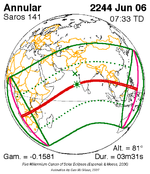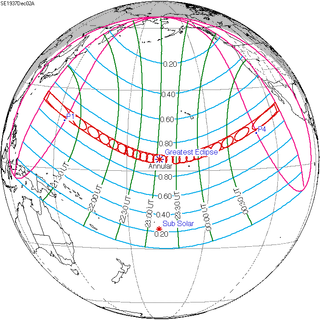An annular solar eclipse occurred on Thursday, December 2, 1937. A solar eclipse occurs when the Moon passes between Earth and the Sun, thereby totally or partly obscuring the image of the Sun for a viewer on Earth. An annular solar eclipse occurs when the Moon's apparent diameter is smaller than the Sun's, blocking most of the Sun's light and causing the Sun to look like an annulus (ring). An annular eclipse appears as a partial eclipse over a region of the Earth thousands of kilometres wide. Annularity was visible from Ogasawara, Tokyo and South Seas Mandate (the part now belonging to Marshall Islands) in Japan, and Gilbert and Ellice Islands (the part now belonging to Kiribati).
| Solar eclipse of December 2, 1937 | |
|---|---|
| Type of eclipse | |
| Nature | Annular |
| Gamma | 0.4389 |
| Magnitude | 0.9184 |
| Maximum eclipse | |
| Duration | 720 s (12 min 0 s) |
| Coordinates | 4°00′N 167°48′W / 4°N 167.8°W |
| Max. width of band | 344 km (214 mi) |
| Times (UTC) | |
| Greatest eclipse | 23:05:45 |
| References | |
| Saros | 141 (19 of 70) |
| Catalog # (SE5000) | 9370 |
The duration of annularity at maximum eclipse (closest to but slightly shorter than the longest duration) was 12 minutes, 0.33 seconds in the Pacific Ocean. It was the longest annular solar eclipse since December 25, 1628, but the Solar eclipse of December 14, 1955 lasted longer.[1]
Related eclipses
Solar eclipses 1935–1938
This eclipse is a member of a semester series. An eclipse in a semester series of solar eclipses repeats approximately every 177 days and 4 hours (a semester) at alternating nodes of the Moon's orbit.[2]
| Solar eclipse series sets from 1935 to 1938 | ||||
|---|---|---|---|---|
| Ascending node | Descending node | |||
| 111 | January 5, 1935 Partial | 116 | June 30, 1935 Partial | |
| 121 | December 25, 1935 Annular | 126 | June 19, 1936 Total | |
| 131 | December 13, 1936 Annular | 136 | June 8, 1937 Total | |
| 141 | December 2, 1937 Annular | 146 | May 29, 1938 Total | |
| 151 | November 21, 1938 Partial | |||
Saros 141
Solar saros 141, repeating every about 18 years, 11 days, and 8 hours, contains 70 events. The series started with partial solar eclipse on May 19, 1613. It contains 41 annular eclipses from August 4, 1739, to October 14, 2460. There are no total eclipses in this series. The series ends at member 70 as a partial eclipse on June 13, 2857. The longest annular eclipse occurred on December 14, 1955, with maximum duration of annularity at 12 minutes and 9 seconds. All eclipses in this series occur at the Moon’s ascending node.[3]
| Series members 17–36 occur between 1901 and 2259 | ||
|---|---|---|
| 17 | 18 | 19 |
 November 11, 1901 |  November 22, 1919 |  December 2, 1937 |
| 20 | 21 | 22 |
 December 14, 1955 |  December 24, 1973 |  January 4, 1992 |
| 23 | 24 | 25 |
 January 15, 2010 |  January 26, 2028 |  February 5, 2046 |
| 26 | 27 | 28 |
 February 17, 2064 |  February 27, 2082 |  March 10, 2100 |
| 29 | 30 | 31 |
 March 22, 2118 |  April 1, 2136 |  April 12, 2154 |
| 32 | 33 | 34 |
 April 23, 2172 |  May 4, 2190 |  May 15, 2208 |
| 35 | 36 | |
 May 27, 2226 |  June 6, 2244 | |
Tritos series
This eclipse is a part of a tritos cycle, repeating at alternating nodes every 135 synodic months (≈ 3986.63 days, or 11 years minus 1 month). Their appearance and longitude are irregular due to a lack of synchronization with the anomalistic month (period of perigee), but groupings of 3 tritos cycles (≈ 33 years minus 3 months) come close (≈ 434.044 anomalistic months), so eclipses are similar in these groupings.
| Series members between 1901 and 2100 | |||
|---|---|---|---|
 March 6, 1905 (Saros 138) |  February 3, 1916 (Saros 139) |  January 3, 1927 (Saros 140) | |
 December 2, 1937 (Saros 141) |  November 1, 1948 (Saros 142) |  October 2, 1959 (Saros 143) | |
 August 31, 1970 (Saros 144) |  July 31, 1981 (Saros 145) |  June 30, 1992 (Saros 146) | |
 May 31, 2003 (Saros 147) |  April 29, 2014 (Saros 148) |  March 29, 2025 (Saros 149) | |
 February 27, 2036 (Saros 150) |  January 26, 2047 (Saros 151) |  December 26, 2057 (Saros 152) | |
 November 24, 2068 (Saros 153) |  October 24, 2079 (Saros 154) |  September 23, 2090 (Saros 155) | |
Notes
References
- Earth visibility chart and eclipse statistics Eclipse Predictions by Fred Espenak, NASA/GSFC
